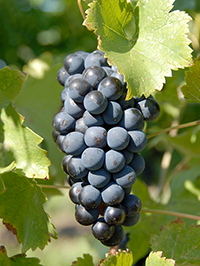The Trick to Making Good Sangiovese
Posted by Matteo Lahm on 24th Mar 2023
Sangiovese is named for the top god in Roman mythology. It means blood of Jupiter. If you’ve made Sangiovese and not been happy with the outcome, you may be wondering why? You’ve successfully made other reds but this one does not seem to want to cooperate. Why has Bacchus refused his blessing on your Sangiovese? Here is your answer. If you want to make a good Sangiovese, keep your eye on your thermometer. While Pinot Noir is known as the heartbreak grape for its unpredictability and difficulty, if the title is deserved, Sangiovese could run a close second. It is a temperamental and fickle grape, but carefully controlled temps are the trick to getting it just right.
Sangiovese does not follow the same rules as most other reds. The optimum range for Sangiovese fermentation is 64°-72° F. That is only an 8° window, and it is a smaller range than most reds, which best ferment between 68° and 80° F. Let’s talk about what you can achieve in the correct range and what will happen if your wine ferments above or below it.

Let’s start at the bottom. If your fermentation temps drop below 64° F, your alcohol will be all ethanol and your wine will have a flavor profile more like a white. Fruit forwardness will be lacking, and your wine might even be too tart. You will probably also get stuck fermentation if you are fermenting with RC-212 yeast. 64.4° F is the temperature threshold for that yeast strain. If you are making a Winexpert kit, that will come with EC-1118 which has a threshold of 53° F. It will eventually ferment dry, but it might take weeks, and you don’t want your Sangiovese to taste like a Pinot Grigio.
At the low end of the optimum temperature spectrum (18°C/64°F), your fermentation process will be slow regardless, and your wine will have higher acidity. The fruit character will be subtle, with notes of green apple, lemon, and lime. It will also be very earthy because more herbaceous characteristics will be maintained through limiting the production of fusel alcohol. Some wine drinkers might prefer this. However, the fruit notes at these temperatures are not typically characteristic of Sangiovese, so you might be disappointed.
That is why the midrange (20°C/68°F) is arguably the sweet spot. The fermentation process is balanced, resulting in a moderate acidity, and a complex flavor profile. The wine will have a pleasant fruit character, with notes of cherry, raspberry, and blackberry, as well as a subtle earthy character. Cherry is the most signature fruit characteristic of Sangiovese. You want it pronounced but not so overpowering that it overshadows other flavors and aromas.
Unfortunately, that is exactly what happens at the high end of the spectrum, (22°C/72°F.) Fermentation is accelerated, resulting in a wine with a higher alcohol content and a more pronounced fruit character. The wine will also have a lower acidity with more jammy and cooked fruit flavors. This is when you will lose some of those counterbalancing earthy characteristics. Also, Sangiovese does not have the body of hardier reds and too much alcohol and fruit forwardness can detract from your subtleties.

Above 72° F, things can get wonky. Many reds like Cabernet Sauvignon and Petite Sirah benefit from venturing into the mid and upper 70’s. Sangiovese does not. It loses too much acidity and gets too fruity. It can even acquire a candy-like flavor which is not pleasant. You will wind up with a flabby wine that is perceptibly off dry with too much alcohol.
If you are a Sangiovese afficionado, there is one exception to point out. If you are knowledgeable about this varietal, you might be wondering why Brunello does not follow these rules? Brunello is technically Sangiovese and it is fermented in the mid 80's. However, this is not problematic because the grapes are larger. It is aged much longer. It has a higher ABV and is much more tannic.
Brunello must be grown in Montalcino, Italy, barrel aged for 3 years and spend a year bottled to legally be called Brunello. It is not grown in the US so you can only work with it as a home winemaker with imported fresh juice or a Brunello kit. Even if you do, unless you are prepared to age it long enough for dominant fruit flavors to relax, and follow the barrel aging and bottling criteria, you do not want to ferment at such high temperatures. Even if you bulk age and add oak, you will not get the micro-oxidation that happens exclusively with barrel aging. Next time you are in a liquor store, compare the years on Chianti and Brunello bottles and you will see Brunello is several years older.
So what can you do? For the home winemaker, those colder temps are unlikely to be a problem if you are fermenting in your house. Typically, the bigger danger is fermenting too hot because it is more likely to happen on its own. If you keep your home at 68° F, you could easily see internal temps in the mid 70s. Keep your fermenter in a cooler space because it will retain heat. If you see those temps creeping up anyway, you can bring them down by moving it to a colder space. In really dire situations, frozen plastic water bottles will help cool things off. Sanitize them and drop them into your fermenter. It is advisable to freeze them before you start your batch, so they are ready if you need them.
If you are making Sangiovese from US grapes, fresh juice, or kits, keep a close eye on your internal fermentation temperatures. Your range is small, and you will get very different results from a change of just a few degrees. Sangiovese is an example of a red grape where fermentation temperatures are more critical to achieving your desired result. Though it is not related to Pinot Noir, they do share some common ground. The fermentation temperature range is lower than average for both, their skins are thin and too much alcohol can significantly dull your flavor subtleties. Next time you make Sangiovese, watch that mercury and act fast if those temperatures fluctuate. It could make or break your batch. With some attention to detail, Bacchus might bestow his good graces after all. Good luck!

